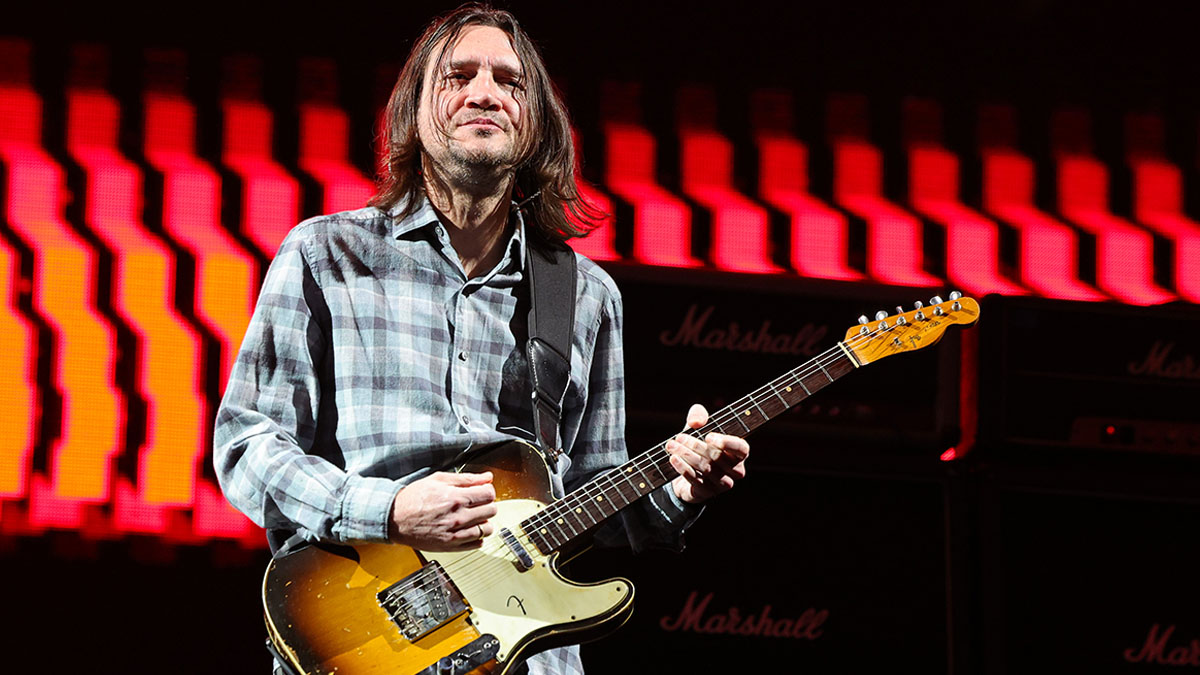John Frusciante says he only found his identity as guitar player when Red Hot Chili Peppers wrote Blood Sugar Sex Magik
Frusciante explains how discovering Television's Marquee Moon an epiphany with Keith Richards' solo on the Rolling Stones' Sympathy For The Devil changed everything

Any guitar players out there who are worried about finding their own voice on the instrument can look to John Frusciante for inspiration, and not just because the Red Hot Chili Peppers guitarist is one of the best players of his generation; he has been there, too, and recently admitted that it was only when the band recorded their breakthrough album Blood Sugar Sex Magik that he found his identity as a guitarist.
Frusciante was guesting on RHCP bassist Flea’s This Little Light podcast, and the honesty and frankness of the conversation made a case for bandmates to interview each other more often.
He told Flea how a guitar teacher telling him he was no good on guitar left a scar. He spoke of just how deep his obsession with Adrian Belew went. It wasn’t just a case of wanting to sound like him. Frusciante said he wanted to look like him, too, and was willing to take drastic action, telling his mother that he was going to shave his eyebrows so they looked more like Belew’s. And his hero’s receding hairline? Well, that could be a new look for him.
“I told her, ‘I think I’m going to shave my head so it goes back like his does right here.’ She’s like, ‘He’s going, bald, y’know!?’” said Frusciante, with a laugh at the ridiculousness. “But I liked the way that looked! I just wanted to be Adrian Belew.”
Steve Vai, another idol, did have thick eyebrows, so that was okay. And Frusciante's obsessions did have its advantages. He learned all Belew’s stuff. He got into Vai in a big way. He spent all day playing Frank Zappa covers with a keyboardist and drummer to develop an understanding of polyrhythms. All this added to his musical vocabulary. The problem was he didn't have an identity of his own.
“I used to attach myself to these other guitar players like Adrian Belew, and Steve Vai after him, and that became my identity,” he says. “Thank God they were people who had a lot of depth to them, and were people who instilled something really positive in me. But I didn’t have any vision of myself.”
When he joined the Red Hot Chili Peppers at the age of 18, Frusciante knew how to play but not what he wanted to play as a guitarist.
Get the MusicRadar Newsletter
Want all the hottest music and gear news, reviews, deals, features and more, direct to your inbox? Sign up here.
“I was so nervous I was just depending on my energy,” he said. “There was a fight or flight mode kind of thing. I didn’t know who I was or what I had to say, what I could contribute to the band. I just knew to put every ounce of energy, play every note like I mean it, play every note like it’s my last. Just stick to the feeling of the band that I loved.”
It was only after the touring for Mother’s Milk had finished that Frusciante had the opportunity to think about what he wanted to do on the guitar, that he found an identity with the instrument. He credits a few things for that.
One was having a conversation with his stepbrother that helped him see the world in a more positive light. Another was connecting with Syd Barrett’s songwriting. But then the big epiphany arrived when he got Television’s Marquee Moon, and Tom Verlaine and Richard Lloyd’s soloing styles changed how he looked at the electric guitar. When it came time to work on Blood Sugar Sex Magik, he knew just what to do.
“When we started writing it that I just relaxed,” he said. “I got into that Television Marquee Moon album and I heard how powerful guitar soloing could be that didn’t depend on having a thick distorted kind of tone, that you could say a lot by playing really simply and almost in a feminine sort of way. Somehow, I had missed that album, and when I got it it made a huge impression on me.”
Revisiting a Rolling Stones classic also taught him a valuable lesson. Keith Richards’ solo, tracked in the summer of 1968, at Olympic Studios, in London, demonstrated that guitar playing didn’t need to be perfect to be perfect
“I was listening to the Stones one day, I was listening to Sympathy For The Devil, and I was like, ‘No guitar solo’s better than that. That is as great a guitar solo as a guitar solo could be.’ Listening to what he was doing, and how sloppy it was, I just threw everything out the window,” he said.
You can check out the full conversation between Frusciante and Flea above. And subscribe to the This Little Light podcast here. Flea’s previous guests have included Stewart Copeland, Tenacious D and Margo Price.
Jonathan Horsley has been writing about guitars and guitar culture since 2005, playing them since 1990, and regularly contributes to MusicRadar, Total Guitar and Guitar World. He uses Jazz III nylon picks, 10s during the week, 9s at the weekend, and shamefully still struggles with rhythm figure one of Van Halen’s Panama.
“Every note counts and fits perfectly”: Kirk Hammett names his best Metallica solo – and no, it’s not One or Master Of Puppets
“I can write anything... Just tell me what you want. You want death metal in C? Okay, here it is. A little country and western? Reggae, blues, whatever”: Yngwie Malmsteen on classical epiphanies, modern art and why he embraces the cliff edge










